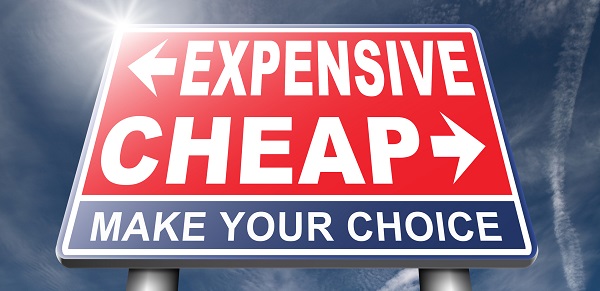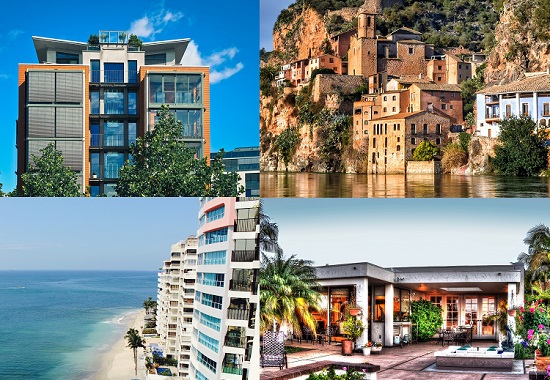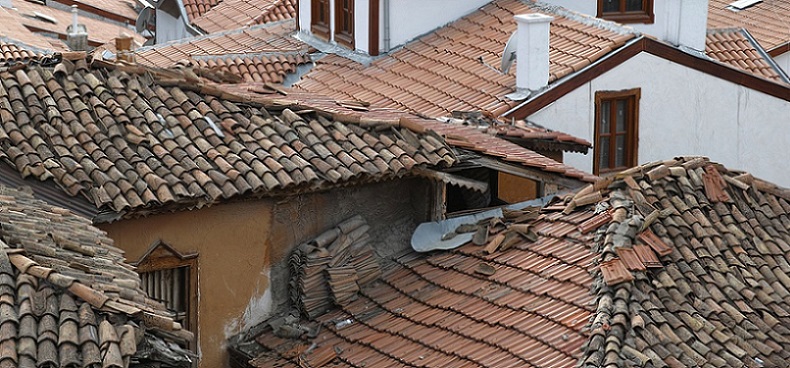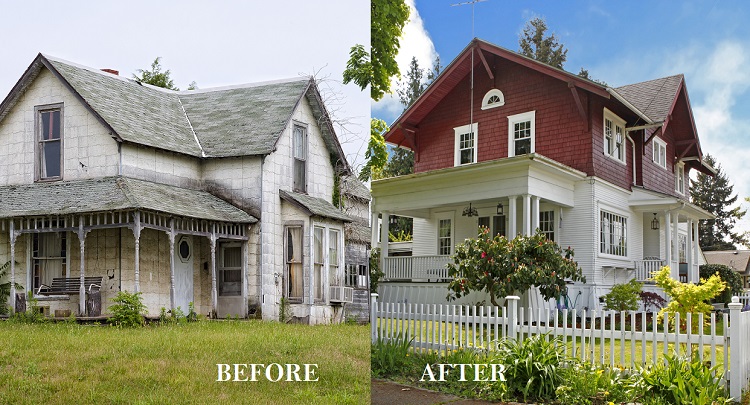Flipping Houses For Profit – Beginner’s Guide
In the USA, Flipping Houses basically involves buying an investment property, renovating it, and selling it for a profit.
I’m sure you have watched house flipping shows, and fantasized about making a nice tidy profit. You get a house that retails for $100,000 to $200,000 range. You make a handsome profitable 54% return on investment say in two “glorious” weeks?
I say “glorious” because the term “reality TV” really applies here. Guys, listen to me. Those are TV shows.
It means everything is scripted with a movie director, actors and well, even the handyman is a talent!
Who Are The House Flippers?
House flippers are property investors who know something that home-buyers normally don’t.
They are willing to buy the ugliest property on the street that you and I will just walk-by. Not to say it’s “haunted” or anything like that, but it is just plain “ugly”.
The property that is overgrown with a junk vehicle permanently parked out front. Things are leaning and falling over. The paint is peeling, the fence has wide gaps. Well you may think to yourself that the house is just a “possible” fixer up.
Bottom line is to buy a “dilapidated” property and improve it so that the average home-buyer gets a home that’s move-in ready.
The truth is the reality TV stars make things look incredibly easy. They have manageable stress and they can make a hefty return over a relatively short time frame (by the time an episode ends!)
If you’re willing to do the entire hard works, then you have a new career carved out for you.
Congratulations, you can become a House Flipper.
Moving Forward With Learning
One of the best ways to grow your wealth is through property acquisition. In the U.S.A., real estate markets in many communities have become more and more erratic.
Traditional real estate sales continue whilst the ability to obtain a mortgage may be difficult and complicated for home-buyers.
Many owners for both residential and commercial properties are seeing their properties go “underwater” with foreclosures at all-time highs.
I have personally flipped dozens of investment properties. I enjoy the passive income and the freedom that this lifestyle gives me.
What I do now is to teach students the fundamentals of Real Estate Auction where you learn valuable key factors during my workshops.
I teach my students the followings;
- Identify the types of properties that are sold through real estate auctions
- Identify types of real estate auction format
- Employ methods to shortlist valuable capital gain properties on the market
- Learn how to go in the 50 U.S. states divided into a total of 3,007 counties
- Understand the benefits to buyers in a real estate auction
- Learn how to gauge the market trends
- Project future use of auctions to capitalize on the real estate market
- Learn how to purchase properties in the USA and flip it (resell it on the market).
- The process of flipping can be continuously repeated

What Are The Basic Steps To House Flipping?
Here are the steps before you decide to leap-frog into your new passive income investment model.
Yes, you can earn $50,000 by flipping a house. You also need to be aware of the risk. You can also lose money if you don’t grasp how to flip a house first before you jump right in.
Even brokers/agents, buyers, and sellers interested in real estate auctions may not have all the information on how this work in the United States.
8 Steps To Your House Flipping Business
Let’s look at the eight steps to help make sure you understand how to flip houses.
Step 1: Research the real estate markets
Sometimes you hear this, “Not every market is a good fit for flipping houses.” So what do you do and how do you know which market is the right one?
First of all, you need to know the types of investment property available in America. What you call home in Singapore and Malaysia is very different in the USA.
You need to know the property types that people want to live in. Where they want to live is also where they can get jobs.
When we do our research at Noble Sky Institute, we deep dive into the area of population growth and where jobs are readily available.
Next, we look at the type of population in these areas.
- Is this a college community or an area with good schools?
- What is the crime rate like in this area?
- Do you find a lot of retirees living here?
We can do all sorts of research and get a lot of data to look at and study.
But the most important thing is to be a realist. This is when I will ask you to ask yourself three serious questions.
- Do you have the money?
- Are you ready to start a business as a property investor?
- What do you expect to earn in terms of percentage over time?
Do you have the money?
Answer 1: Yes
Answer 2: No
Answer 3: Maybe
Seriously guys, if your answer is anything apart from YES; I will say you are not ready.
Are you ready to start a business as a property investor?
If you live in Singapore or Malaysia, these rules apply when you want to start an investment.
- If you want to start any business you will need a capital.
- If you want to start a business as a property investor you will need a bigger capital.
- If you want to buy a property you will need to qualify for a mortgage or bank loan to buy the property.

What do you expect to earn in terms of percentage over time?
If you are happy with the Fixed Deposit rate that you are receiving and want zero risks, then maybe property investment will not give you the immediate monthly returns.
If you have a huge risk appetite and are already making more than 60% trading online, perhaps property investment may be too slow for you.
What you expect to earn in terms of percentage over time is not a one size fits all equation.
If you are already a property investor and want to diversify your portfolio to the USA, please feel free to contact us for a private meeting. I would be happy to meet with you to discuss privately.

For Newbies, Let’s start small
Let’s look at your capital. If you have $10,000 to start with, then you wouldn’t want to be looking at a suburb where the home prices start at $1,000,000.
I know it. You know it too. There is no end to financing that could ever bridge that gap!
You got to be realistic guys. No bank is ever going to approve that kind of loan. With the little that you have, you need to look at lower home prices. Find something you can afford.
There is a mega difference between a 20% down payment on a $100,000 property and 20% down payment on a $1,000,000 property. While you think about that, let’s look at the Property Classes that describe the neighborhoods you want to invest in.
How To Identify Property Class Types?
Property classes describe the characteristics of a potential real estate investment and the neighborhood each home is located. Each class holds a certain value relative to the market they’re in and their “class” ranking, from A to D.
Class A – The wealthiest housing markets (higher-income professionals, businessmen, celebrities)
Class B – Solid middle-class
Class C – Blue-collar (working-class)
Class D – Low-income earners
Class A Property
A safe prime location in a good school district, newly built properties with high-end finishes, close to country clubs, with access to highways, shopping, and medical facilities.
Class A properties are owner-occupied, well-maintained homes and neighborhoods, as they have invested directly in the area.
Rental in Class A rental properties is usually high in demand as the homes are newer and lower maintenance costs.
Class B Property
Class B Property may be slighter older than Class A but are well managed with quality tenants.
The properties are more investor-owned and tenanted properties. The building’s location and circumstances may allow the area to be “upgraded” to a Class A with improvement, renovation or even façade upgrades.
Class B properties offer the opportunity for investors to create a substantial cash flow.
Class C Property
Class C properties are typically more than 20 years old with visible deterioration and are located in higher crime areas. These are predominantly investor-owned and occupied by tenants in lower socio-economic groups.
Class C properties carry the highest risk of any classification. Even though the properties offer the potential for the highest cash flow, they need a lot of improvements and hands-on management.
Class C properties can be very lucrative investments with the right strategy and are only taken on by experienced investors and property managers.

How To Decide Which Property Class To Invest In
It is most important for investors to understand that each class of property represents a different levels of risk and reward.
Class A properties generally offer lower cash flow than a Class B or Class B investments.
The high demand for a Class A property means an initial higher purchase or acquisition cost. These properties are higher in demand and are generally easier to sell.
What I tell my students is this. Keep it simple. Whether it’s Class A, B or even C, all you need to do is to find the ugliest property on the prettiest street, buy that cheap and rehab it to sell.
The right investment decision is one that you are able to value-add to the property to turn it into a home that people want to live in.
This is how you make a profit. Again, it’s all relative.
Whether you want to spend your time targeting a Class B or Class C property for your first deal, remember you can always find an older aged property to rehab. What you need to do is to convince the owner to sell to you.
Believe me; you might want to skip the bottom rungs of the ladder, the Class D neighborhoods. You will not want to deal with the headaches that come with additional risks relative to the cheaper purchase price.
As in many low-income neighborhoods, where the majority are tenants, you will likely be flipping to a fellow investor (a landlord), rather than a homeowner.
Flipping to another real estate investor often means lower margins but a smoother sales process. Investors can settle quickly, know what they’re looking for, and know how to purchase with no muss and no fuss.
As a final note, if the area that you’re looking at is outrageously expensive, do consider investing in another area.
Step 2: Set a budget with a business plan in place
You have seen the “reality TV” shows. You like the lifestyle these real estate investors slash entrepreneurs project.
You think to yourself, “It’s a pretty cool way to make big bucks!” Stop right there.
Remember, real estate investors are entrepreneurs. They’re in business and they have a business plan. You need a business plan to succeed.
Here’s a more detailed look on how to create a house flipping business plan.
Basically You Plan The Flip and Flip the Plan
What this means simply is get your budget, project scope and timeline in place. This is your business plan. Keep it simple. It doesn’t have to be fancy or filled with corporate lingo.
Let me help you out with these questions to help you get started.
- How much do you have to invest?
- How much do you want to hold in reserve?
- Do you have enough to cover rehab cost?
- What kind of scope are you comfortable with?
- Are you able to hold the property until you sell?
For Newbies, I would recommend that you start with a relatively new property for your own first house flip. Stay away from older properties which may have structural and mechanical problems.
If you need to tear down and rebuild you will need permits and approvals. I’m sure you don’t want to deal with this kind of hassle on your first house flipping deal.

I would recommend starting with relatively simpler cosmetic updates. Change the kitchen cabinets, bathroom fittings, fix new flooring, and change the fixtures and lights and finally a new paint.
Yes, your margins will be narrower.
What you want is to move the project along. Speed is important. With lower risk, you put in less cost to fix up the place; it just means you make a lesser profit.
Step 3: Get your financing in place BEFORE you need it.
Seriously, you need to get your money ready. You will need it. Way ahead of starting out your business, make sure you qualify for a mortgage and know what your limit is.
Is your bank able to fund you up to 90% or is it 80% of the purchase price for investors flipping houses? What is the percentage for rehab costs? Is it a full 100%?
Before you make an offer, make sure your bank or lender can fund your deal. You will need the money in place. The last thing you want to do is to quickly come up with the money when the negotiation has gone through.
If you need bridge loans for flipping houses, you need to do your homework. Pay close attention to interest rates. Compared to long-term traditional homeowner mortgages, interest rates will be high on all bridge loans.
Check and find out your total flipping costs including all fees you need to pay.
Step 4: Start networking and working with contractors
The crucial part of the equation of flipping a house is getting the Contractor’s price or quotes in early. You will want to know the numbers way before the property is under contract.
You do this by networking and start building relationships with contractors before you buy your first flip.
Getting a house ready for a flip involves the expertise of a good network of contractors: general building contractors, roofers, plumbers, electricians, HVAC experts, and painters.
You will also need to know several reliable lower-cost, well-rounded handymen who will fix small things on the property.
Half of the house flipping business involves building a network of a home inspector, contractors, and a Realtor who is able to sell the property for you.
Step 5: Find a house to flip
The most crucial part of learning how to flip houses is not the part that you see on “reality TV”. You got to have a nose for good deals, this means buying below way market value.
My team and I will deep dive into research to find the properties. We work out our margins ahead to know our numbers. Getting a wide enough margin will cover many of your expenses like;
- Closing costs
- Rehab costs
- Realtor’s fees and
- Cost of your time and work
There are many strategies to find below-market deals on homes to flip. Here are a few that you could consider working with;
- A Realtor to find on-market deals
- Wholesalers to find off-market deals
- Build a direct mail marketing campaign
- Buy from an Auction
Finding good deals for flipping houses is simply a test of patience. Have a business plan in place. Remember that when the property looks too tempting to resist if the numbers don’t meet your minimum, pass and keep looking.
You don’t have to buy the first property that comes your way. You will want to buy the best property with the money you have. If the project scope is larger than you can manage, believe me, it is larger than you can manage.
Step 6: Buy the house
Now that you have won the auction, the next step is to pay the county. The process takes time. Once you have the legal paperwork in place, consider hiring a home inspector to conduct a comprehensive survey and get the numbers down for rehab.
If you are a newbie, you may want to stick to some minor interior modifications, cosmetic repairs, some work to spruce up the exterior, and a new coat of paint.
For serious rehab of dilapidated properties, you will need to make sure that property is structurally sound. Then you will need to check that the plumbing, electoral and mechanical systems are in good working order.
These types of home inspections take several hours and are incredibly comprehensive. Walk through the property with several contractors to get multiple quotes. Each contractor has a different approach to carrying out the works.
It is important that you hear the contractors out and get a sense for the differences which could work out to savings in money and time!
Once the contractors put in their quotes, you need to review, select and negotiate with the winning bidder. Schedule the contractor to start on the day you get the keys to the property.

Step 7: Renovate
Once you’ve settled the paperwork and made the payment, it’s time to start work! Remember the first rule of business.
Every hour, every day and every month that goes by, you’ll be paying interests and other costs or owning your property.
You need to keep in mind the following that you will be paying for while you spend precious time working with contractors and builders to rehab your property.
- Insurances
- Utilities
- Taxes
- Any other costs
All these translate to you losing money. The sooner you start and complete the rehab, the faster you are able to put the property on the market and sell it to pay off your loan. So you need to be prudent and efficient.
Time management is critical in getting things done and underway. If you have worked with contractors before, you will know how they sometimes mess with you.
Something that takes a week to complete is still in progress a month later. If the delay continues, every other trade will just slow down because of the initial delay.
Flipping homes successfully are all about being efficient and keeping your eye on the clock. Another important thing to take control of is the project pricing.
You need to work with a reputable contractor to give you a comprehensive quotation so that there are no surprises mid-way through the rehab.
So choose contractors well. If you’ve never worked with a new contractor before, you may consider call as many references and past clients as possible.
Step 8: Sell it!
The final step of flipping homes is may seem to be the simplest – selling it! You can’t save money on this part and think that you could market the property yourself. You need to hire an expert Realtor who knows the market.
Making a big bang for your bucks means simply knowing your numbers. Make sure you know and understand the fundamentals of real estate BEFORE you decide to buy your first investment property to flip.
Remember you are the one responsible for the pricing as your profits depend on it.
There are many part-timers, freelancers and generalist who are experts to in your specific market. Getting an expert Realtor who knows the market to handle your property will save you money in the long run.
First, you get the Realtor’s opinion on the after-repair value (ARV) before even putting a contract on the property. You can capitalize on your Realtor’s expertise for pricing.
Now that you have the strategies, to help you get started, you need to decide if you can invest the time and money to put flipping homes into practice.
Your first deal will be the most exciting and can also be the most stressful. Lean in on my expertise and learn from your lender, your contractors, and your home inspector to your Realtor.
My final thought on flipping houses is when in doubt; get a second or even a third opinion. If you have any questions, do get in touch with me and learn from my mistakes, so you don’t have to make them on your own.
I have done this on my own for over 16 years. Noble Sky has done this professionally for 5 years. We have the knowledge and the expertise to guide you with deep level research and preparation.
But you have to make that first decision, which is to take the action. Only by taking action you will create successful results and earn you profit.
We love Flipping homes as a community of property investors. This is where our professional network comes in to help you get the best deal possible.


Amazing ideas on property business I am really attarcted and unfortunately for the beginner requirement to have at least 20% of the capital which is $200.000.
Hi there is a way to work with capital at way lesser than that.
We have a proven working model that leverages on other investors to make things work alot simpler.
Do drop us a line via whatsapp on https://wa.me/6594220100 for more info.